Thursday September 25, city leaders, members of the IndyGo executive board and MPO will hold a ground-breaking ceremony for the new Downtown Transit Center. Situated on the Southeast corner of Washington and Delaware, the transit center will be the new hub for buses that travel downtown. This edifice will be a much needed and welcomed alternative to the current cluster along Ohio Street. At this point, only certain details regarding the design, costs, and retail center have been released to the public. The center will have 20 bus bays, bicycle racks, and general seating inside. However, details regarding which routes will go to the center, operating hours and what the retail center will consist of are still up in the air. One can hope that it will at least be open to the public for the same span as IndyGo service hours, but that remains to be seen. IndyGo is still accepting public input via online surveys as it sorts out the aforementioned factors. Perhaps a look at how 3 comparable cities operate their transit center will help in hashing out the final details.
- Bloomington Transit Center; Bloomington, IN
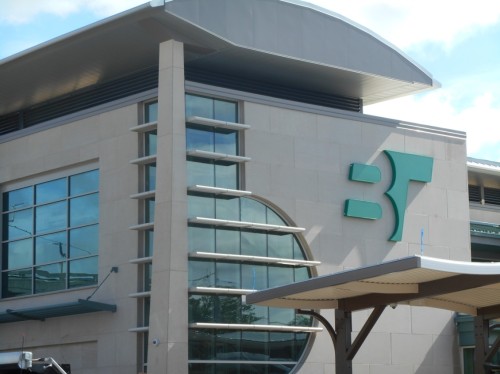
Photo credit: http://bloomingtontransit.com/news/new-downtown-terminal/
The Bloomington Transit center opened on August 18, 2014. Like the new transit center in Indianapolis will have, the Bloomington Transit Center has an indoor waiting area with Wi-Fi, canopied outdoor waiting areas, LED screens showing real time bus information, and bike racks and lockers.
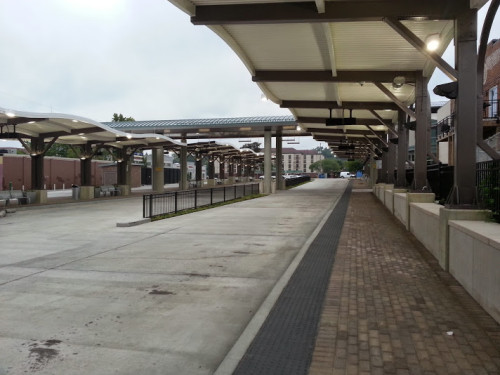
Photo credit: Kevin Kastner
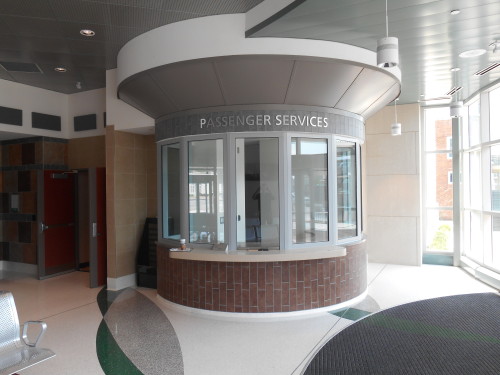
Photo credit: http://bloomingtontransit.com/news/new-downtown-terminal/
The building is two stories with a large multipurpose room for employee training on the first floor and police dispatch offices with uniformed police personnel on the second floor. There is also a passenger services booth centralized on the first floor.
- Riverfront Transit Center; Cincinnati, OH
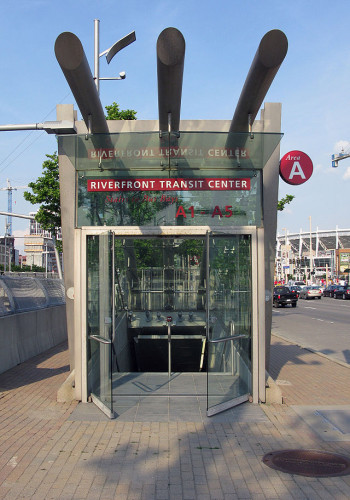
Photo credit: http://www.go-metro.com/rtc
The Riverfront Transit Center in Cincinnati opened for service 10 years ago. The center is unique in that it is underground under 2nd Street and is adjacent to Great American Ball Park, home of the Reds, and Paul Brown Stadium, home of the Bengals. The center can handle up to 500 buses and 20,000 commuters per hour during sporting and other events. The transit center’s special occasions only usage has come to the chagrin of many local residents. The center has 20 bus bays, which are used predominately by private charter buses that drop off game day spectators. The center is not a regular public space, as posted by the centers rules and regulations which state there is to be no eating, drinking, smoking or loitering in or around the center.
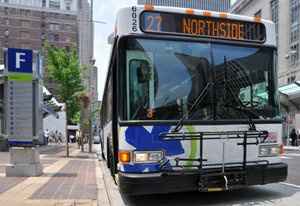
Photo credit: http://www.go-metro.com/riding-metro/government-square
Currently, Cincinnati utilizes a landmark known as Government Square as a transportation hub in the downtown area. Government Square is bound by 5th and 6th streets to the south and north and Main and Walnut streets to the east and west. This area is slightly comparable to Indianapolis’ usage of Ohio Street, though it boasts large, attractive bus shelters and a booth with planning and scheduling information.
- Charlotte Transportation Center; Charlotte, NC
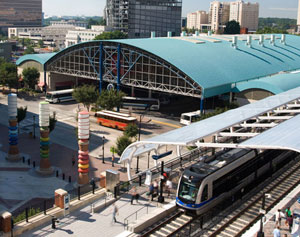
Photo credit: http://charmeck.org/city/charlotte/cats/Bus/Pages/transitcenters.aspx
The final city on our list, Charlotte, is unique in that the city has smaller transit centers designed to fit certain neighborhoods in addition to its main center in uptown Charlotte. The Charlotte Transportation Center is the main multimodal hub in Charlotte for the city’s bus and rail routes. The center is open to the public during regular transit hours, 4:50 AM to 1:30 AM daily. Shops and restaurants within the center are generally open during normal business hours, 7:00 AM to 8:00 PM on weekdays only.
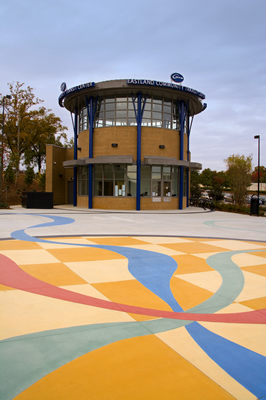
Photo credit: http://charmeck.org/city/charlotte/cats/Bus/Pages/transitcenters.aspx
The Eastland Community Transit center, located at Charlotte’s Eastland Mall, opened in October 2006. The open air plaza is spread over 1.5 acres and comes complete with covered passenger waiting areas, a small building which houses the driver comfort station, and up-to-date passenger information.
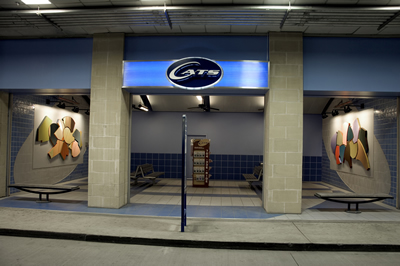
Photo Credit: http://charmeck.org/city/charlotte/cats/Bus/Pages/transitcenters.aspx
The SouthPark Community Transit Center was the first transit center to open in Charlotte in December 2004. This center is actually located in the parking deck of SouthPark Mall between the Belk and Dillards stores. The waiting area is climate-controlled, displays bus routes and schedule information and is monitored with video surveillance at all times.
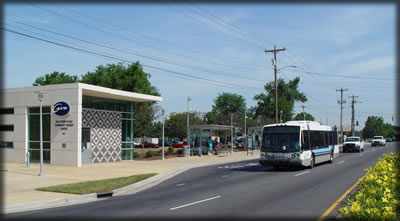
Photo credit: http://charmeck.org/city/charlotte/cats/Bus/Pages/transitcenters.aspx
The fourth and final, as to date, transit center in Charlotte is the Rosa Parks Place Community Transit Center. Nestled in one of the most transit-supportive neighborhoods in Charlotte, the Beatties Ford Road area, this center allows neighborhood residents a nice, safe and weather-protected facility to board buses. The center opened in 2006 and is served by 4 routes.  It also has on-site surveillance during transit hours and attractive sidewalks and landscaping like Charlotte’s other transit centers.
With Thursday’s ground breaking ceremony, Indianapolis will be taking one step closer to incorporating transit into the values of the city and its residents. A look at the aforementioned cities would leave many scratching their heads as to why Indianapolis, a city with approximately 900,000 people and a metro area of over a million, took so long to create something as useful and necessary as a transit center. To that, the simple response is ‘better late than never’. With its sleek design, the new downtown transit center has the potential to be the initial spark of energy into the newly dubbed Market East neighborhood. Perhaps once it is established, the center can spawn off neighborhood transit centers around the city. Imagine what a neighborhood transit center could look like at any of the city’s malls. Imagine what could become of abandoned corner areas in Center Township; 38th and Arlington maybe (if a gas station doesn’t get there first)?  Who knows how far transit will go in the future of Indianapolis. At least it’s finally leaving the station.
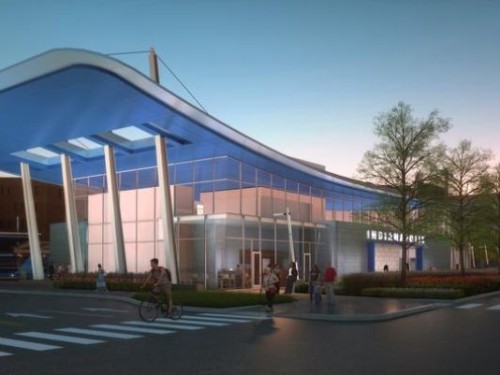
References:
http://www.indygo.net/pages/downtown-transit-center
http://bloomingtontransit.com/news/new-downtown-terminal/
http://en.wikipedia.org/wiki/Riverfront_Transit_Center
http://www.go-metro.com/rtc
Wetterich, Chris. (2013). Deserted downtown transit center may get new life. Â Cincinnati Business Courier. Retrieved from http://www.bizjournals.com/cincinnati/news/2013/04/23/deserted-downtown-transit-center-may.html?page=all
http://www.go-metro.com/riding-metro/government-square
http://charmeck.org/city/charlotte/cats/Bus/Pages/transitcenters.aspx
http://www.indystar.com
I need someone to talk me back into loving Indy as I’m losing my interest in it. I’ve been here for 13 years after coming here to attend college at Butler – so I’ve seen Indy through a number of years now. It just seems to move at a snails pace on mostly everything and be 10-20 years behind other cities that are even smaller than Indy. Is it just the culture of the area or is this really the modern rebirth of Indy now where it can properly step into the 21st century with things like the transit hub? This hub is nice, but I really want to see access to mass transit making other places other than downtown Indy walkable and urban. Can someone please give me some new optimism?
I don’t know how often you travel, but I couldn’t disagree more. Perhaps we lag behind in mass transit but I think we perform pretty favorably in most other areas – especially compared to our Midwestern peers.
Jim, I am in the same boat. I have lived here ever since graduatinig and while some nice things are happening in the city, like you said, everything moves at a snails pace. I think it has to do with the conservative mindset of so many in the city and state. When you travel to cities like Austin, Nashville, Portland, Minneapolis, Charlotte, you can see how much Indy is falling behind.
Would love to hear what you think each of those cities has that puts them ahead of Indy (other than mass transit for those who have it), particularly the ones with higher costs of living.
What city, in their downtown core, has anything even remotely resembling the Cultural Trail? Even Portland, a west coast, bike-friendly city (that stole Curt from us!), is totally jealous of our separated 7 mile bike/pedestrian path.
The development that will be happening by the jail and the rest of the old Market Square site is just a testament to what is happening in Indy.
I’ll personally say that the biggest failure of the recent year or two is the lack of push to convert the downtown one ways into two ways. It doesn’t matter how many buildings are built/rehabbed along Pennsylvania, Delaware, New York, Michigan, capitol, and Illinois as long as residents of those buildings have to deal with high-speed arterials and the noise, pollution, and danger that goes along with them.
Thanks Shayla for the story. One thing though … In the last paragraph you said that Indy has a metro area of “over a million”. While technically true, it is best to at least round to the nearest million. The Indy MSA population, according to the US Census Bureau, is about 1,970,000 now – so it would be much more accurate to say that the metro area’s population is “almost two million”. It should hit 2 million sometime in the mid to late part of 2015.
“…took so long to create something as useful and necessary as a transit center”
We’ve actually had a transit center (Union Station) for well over 100 years now. We just don’t use it. Its a shame we didn’t dream bigger on this project and restore that classic building instead of building a new center (which I doubt will be around in 100 years).
Look at Denver’s newly – restored Union Station and how its transforming that downtown, a place of similar size and development patterns.
You’re absolutely right, Matt. Don’t forget we also had the traction terminal.
This isn’t a transit center, it’s a bus terminal. Who was the genius behind this project and its location?
Denver is an excellent case study in what can be done if you have some vision and real planning goals. Our Union Station is much more centrally located than theirs.
You don’t need a big, shiny transit center for it to be successful. Look at Europe, in Rome their bus center at Vitorio Emmanual is just some curbs delineating loading space.